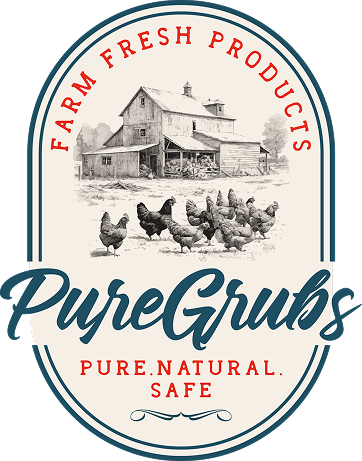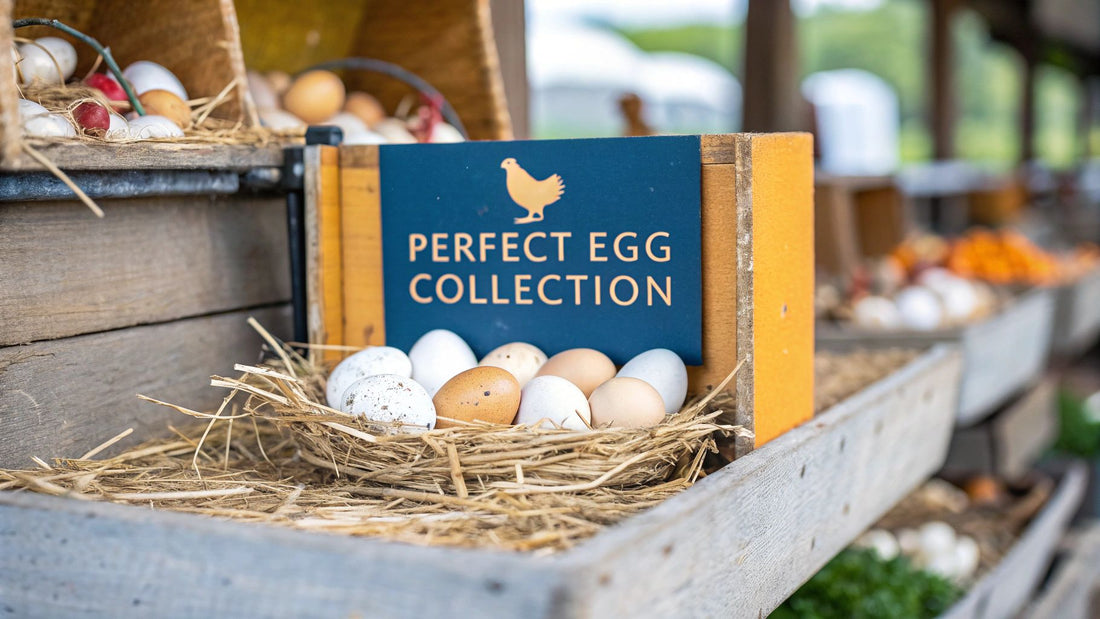
Your Guide to Perfect Chicken Coop Egg Collection
Share
The secret to a simple chicken coop egg collection routine is all in the planning. Seriously. If you design your coop with egg gathering in mind before you even have chickens, you can turn a daily chore into a quick, satisfying task. It all comes down to creating a nesting area so perfect your hens won't consider laying anywhere else.
Designing a Coop for Effortless Egg Collection
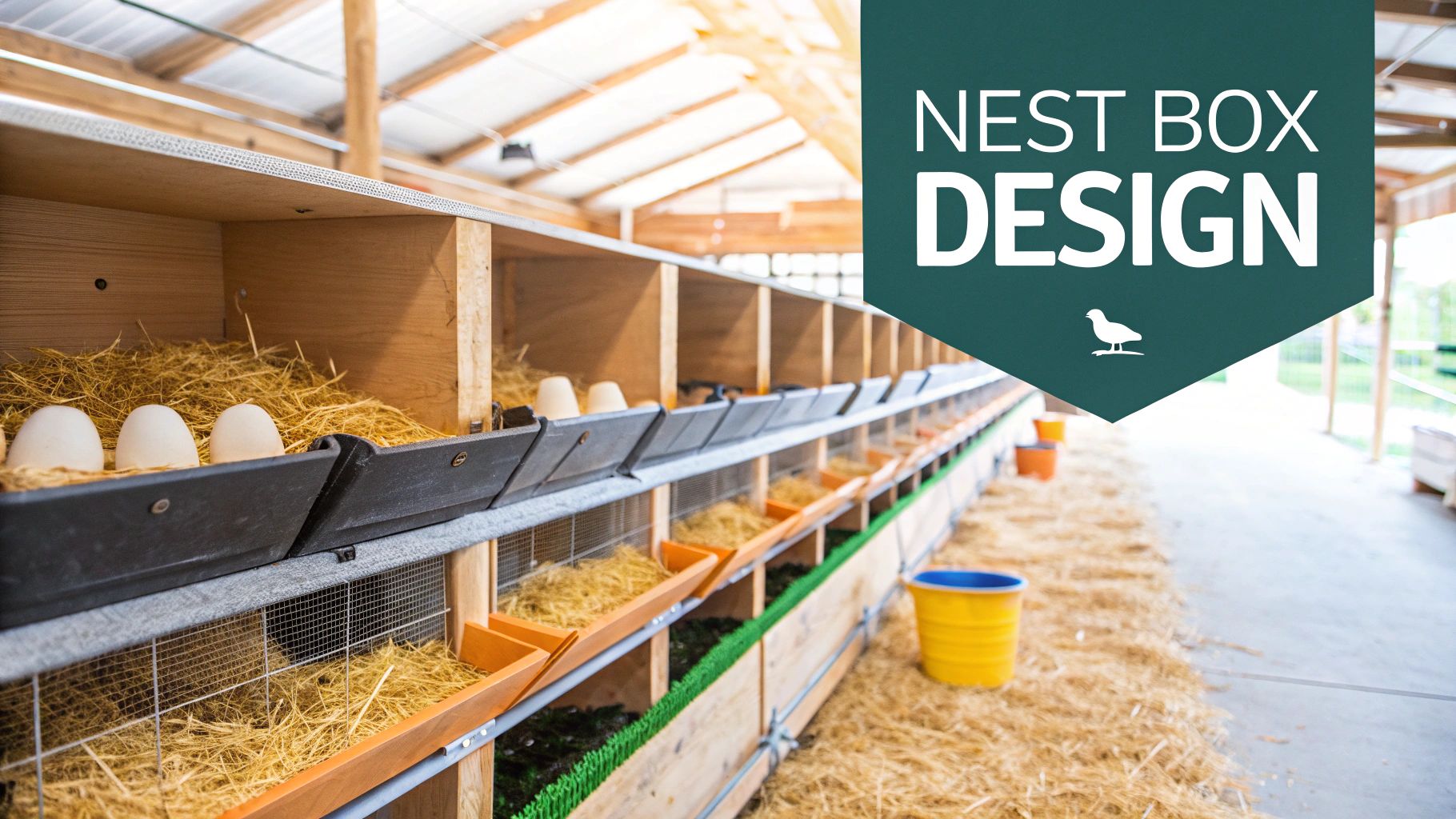
A smart coop layout does most of the heavy lifting for you. The whole idea is to make the official nest boxes so appealing that laying eggs under a dusty bush or in a random corner never even crosses your hens' minds.
Smart Nest Box Placement and Design
Where you put the nest boxes is probably the most important decision you'll make. Hens are hardwired to find dark, private, and secure spots to lay their eggs. If your nest boxes are sitting in a busy, brightly lit area, you're practically asking for a daily egg hunt all over the yard.
Try to position your nest boxes:
- Away from the main entrance to cut down on foot traffic and disturbances.
- Lower than the roosting bars. This is a big one. It discourages them from sleeping (and pooping) in the nesting area.
- In a dimmer corner of the coop, far from direct sun or harsh lights.
If you want the gold standard of convenience, look into an external roll-out nest box. These are built into the side of your coop and have a lid on the outside for access. The floor inside is gently sloped, so after a hen lays an egg, it rolls safely into a covered collection tray. This design is a game-changer—it keeps eggs spotless, safe from pecking, and lets you complete your chicken coop egg collection in seconds without ever stepping inside.
Key Takeaway: A roll-out nest box is the single best upgrade for easy egg collection. It prevents breakage, keeps eggs clean, and stops bad habits like egg-eating before they can start.
Creating an Irresistible Laying Environment
Once you've got the location down, the inside of the box needs to be cozy. For a hen, comfort is everything. A hard, bare floor is a definite no-go and a primary cause of cracked eggs.
Your choice of bedding really matters here. Fluffy straw is a classic for good reason—it’s soft and provides great insulation. Pine shavings are another popular choice, especially for their absorbency. You can also find specialized nesting pads that give you a durable, easy-to-clean surface while still cushioning the eggs.
At the end of the day, a hen’s laying habits are directly linked to her health and happiness. A great coop design is vital, but so is making sure she has the right nutrition to produce strong eggs in the first place. If you want to dive deeper, our guide on how to increase chicken egg production has some great tips on diet and care. When you pair a fantastic coop with top-notch flock management, you build a system that benefits everyone.
Establishing a Daily Egg Collection Rhythm
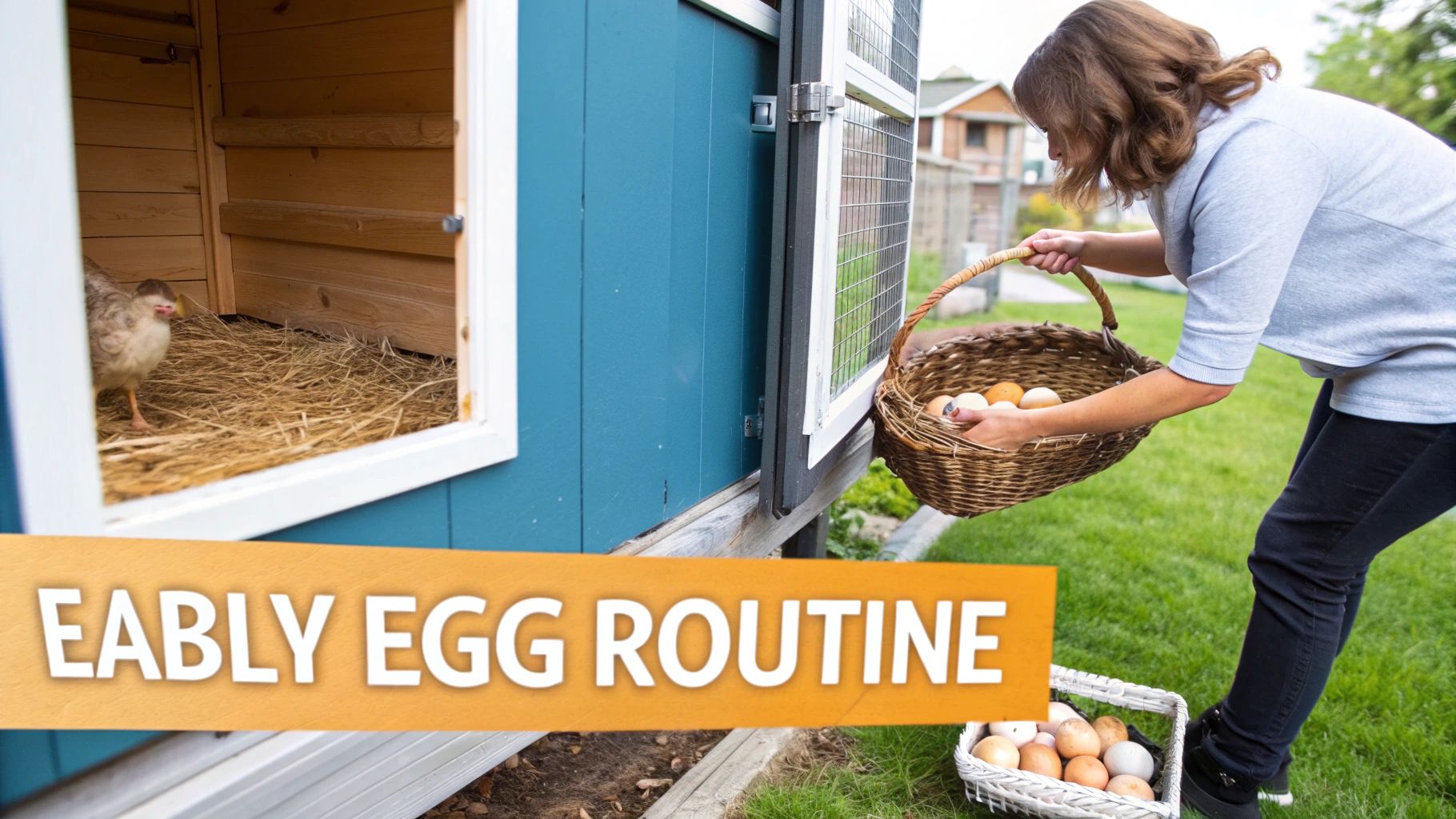
When it comes to chicken coop egg collection, consistency is your secret weapon. This isn’t just about grabbing eggs whenever you happen to remember; it's about creating a predictable rhythm that keeps your flock healthy, your eggs clean, and your breakfast basket full. A solid routine transforms a simple chore into one of the most rewarding parts of keeping chickens.
Most hens are early birds, laying their eggs within six hours of sunrise. This biological clock makes mid-morning, usually between 10 AM and noon, the perfect time for your first collection run. By then, the morning rush in the nest boxes has died down. I also highly recommend a second sweep in the late afternoon.
Making two trips a day might sound like extra work, but it pays off in big ways:
- Prevents Breakage: An empty nest box is a safe nest box. Fewer eggs piling up means a much lower chance of them cracking against each other.
- Reduces Contamination: Getting eggs out quickly limits their exposure to mud, manure, and moisture, giving you cleaner eggs from the start.
- Thwarts Egg-Eaters: Prompt collection removes temptation for any curious hen that might think about pecking at an egg, a habit you definitely don't want them to start.
- Weather Protection: In the summer, it gets eggs out of the heat. In the winter, it saves them from freezing and cracking.
The Calm Approach to Collecting
How you enter the coop makes all the difference. Bursting in can spook your flock, especially a hen who's in the middle of her important work. I've found it's best to move slowly and speak in a calm, quiet voice as you get near the nesting area.
If you find a hen on the nest, don't force her out. You can either wait a few minutes for her to finish or, if you know she's a calm bird, gently reach underneath her to grab the other eggs. Over time, your chickens will get used to this gentle intrusion, and collection time will become a peaceful part of the day. Some of my own hens barely look up anymore.
A consistent, gentle routine does more than just fill your egg basket. It builds trust with your flock and provides a daily opportunity to observe their health, check for signs of stress, and ensure everything in the coop is running smoothly.
Turning Routine into Observation
Think of egg collection as your daily wellness check. While you’re gathering, take a quick scan of the coop. Are the nesting boxes still clean? Is the bedding dry? Do the hens seem happy and active?
This is your chance to catch small problems before they become big ones. You might notice a drippy waterer, the first signs of mites, or a hen that seems a bit off. Spotting these things early is what separates a good chicken keeper from a great one.
By weaving this simple rhythm into your day, chicken coop egg collection becomes more than just a task. It’s a core part of managing a happy, healthy flock and the key to getting beautiful, high-quality eggs every single day.
How to Handle and Store Fresh Farm Eggs
Once your chicken coop egg collection is done for the day, what you do next is just as important as how you gathered them. Getting those eggs from the coop to the kitchen while keeping them fresh and safe is an art, and it all starts with understanding the egg's own clever design.
Every single egg comes with a built-in, invisible shield called the bloom, or cuticle. This natural coating seals the tiny pores on the shell, locking out bacteria and keeping moisture in. Think of it as nature’s perfect packaging. Preserving that bloom is the secret to making your eggs last as long as possible.
This visual guide breaks down the simple choices you'll make to keep every egg in top condition.
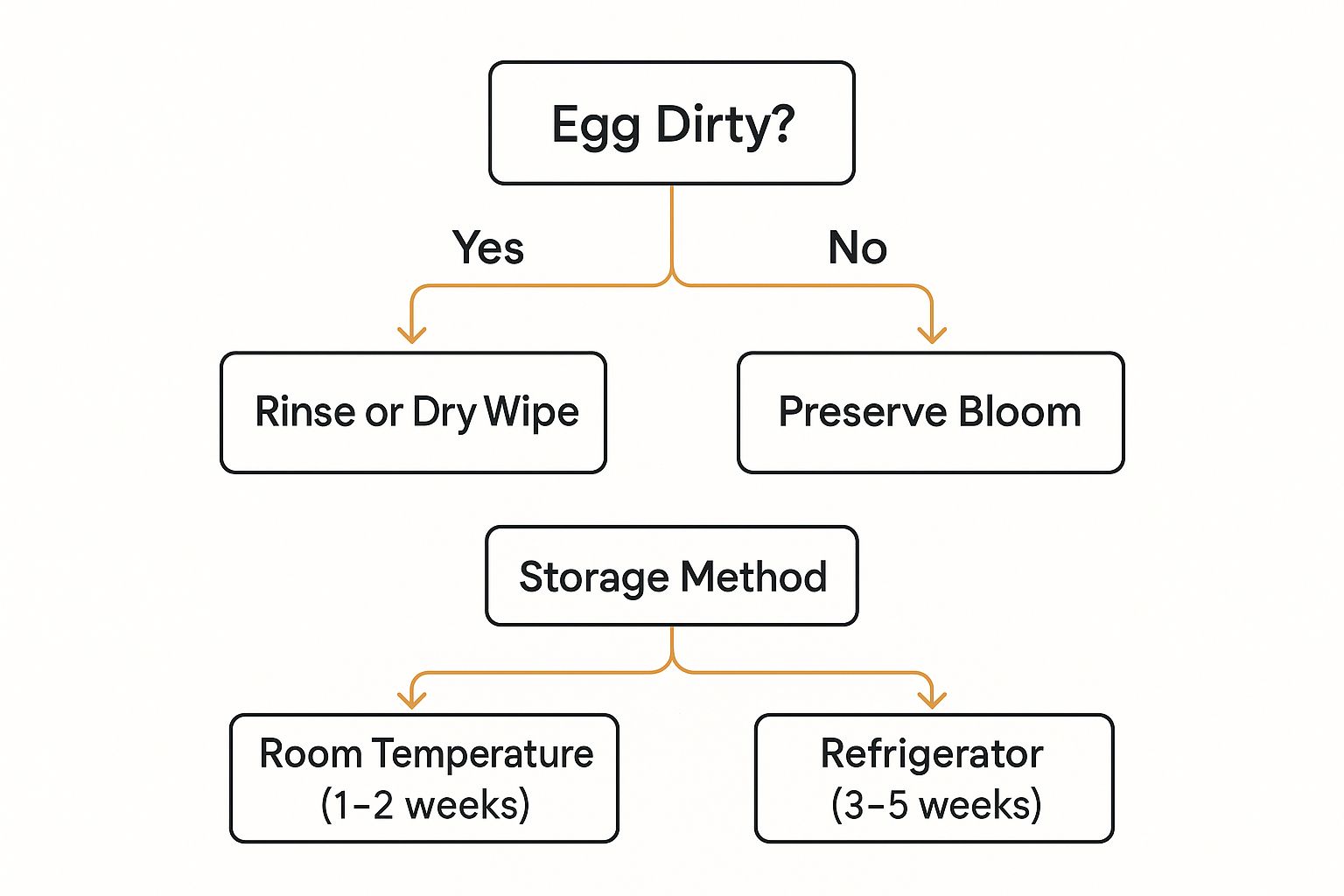
As you can see, the first big decision—to wash or not to wash—sets the stage for everything that follows.
To Wash or Not to Wash
The great egg-washing debate isn't as complicated as it sounds. My rule of thumb is simple: if an egg comes out of the nest box looking clean, leave it alone. The bloom is your best friend for freshness.
Of course, life on the farm isn't always clean. Sometimes eggs get a bit of mud or manure on them, and in those cases, you'll need to clean them up.
- Dry Cleaning: For a little smudge, I just use a dry brush, a scrubby sponge, or even a piece of fine-grit sandpaper to gently buff the dirt off. This is always my first choice because it messes with the bloom the least.
- Wet Cleaning: If an egg is seriously caked in muck, you'll have to use water. The trick is to use water that’s warmer than the egg, somewhere around 90-120°F (32-49°C). This warmth makes the egg’s contents expand just enough to push contaminants out of the pores. A quick rinse is all you need—never let an egg soak.
My Biggest Tip: When you have to wash an egg, always use warm water. Cold water creates a vacuum effect that can literally pull bacteria from the shell's surface right into the egg.
Proper Storage for Maximum Freshness
How you store your eggs depends entirely on whether they’ve been washed. An unwashed egg with its bloom intact can sit safely on your counter at room temperature (below 68°F or 20°C) for about two weeks.
Washed eggs are a different story. Once that protective bloom is gone, they must be refrigerated right away. The cold temperature is what slows down bacterial growth.
Whether washed or not, always store your eggs with the pointy end down. This simple trick keeps the yolk centered and the air cell stable at the top, which helps maintain that farm-fresh quality. If you want to get ahead of the game with strong, clean eggs, take a look at our guide on how to improve egg quality.
With worldwide egg consumption having jumped 14% in the last decade, knowing these simple handling tricks is more valuable than ever. In the U.S. alone, we've gone from eating 14.0 kg to 16.4 kg of eggs per person annually. Proper storage means every backyard chicken keeper can contribute a safe, fresh supply.
The Simple Float Test
Ever find an egg and wonder if it's still good? The float test is a classic, foolproof method. Just grab a bowl of water and place the egg inside:
- Sinks on its side: It's as fresh as can be.
- Stands on one end: It's a week or two old. Still perfectly good, but you'll want to use it soon.
- Floats to the top: It's past its prime. Time to toss it.
This works because as an egg gets older, the air cell inside grows, making it more buoyant. With these tips in your back pocket, you can be confident that every egg your flock gives you is as delicious as it should be.
Solving Common Egg Collection Headaches
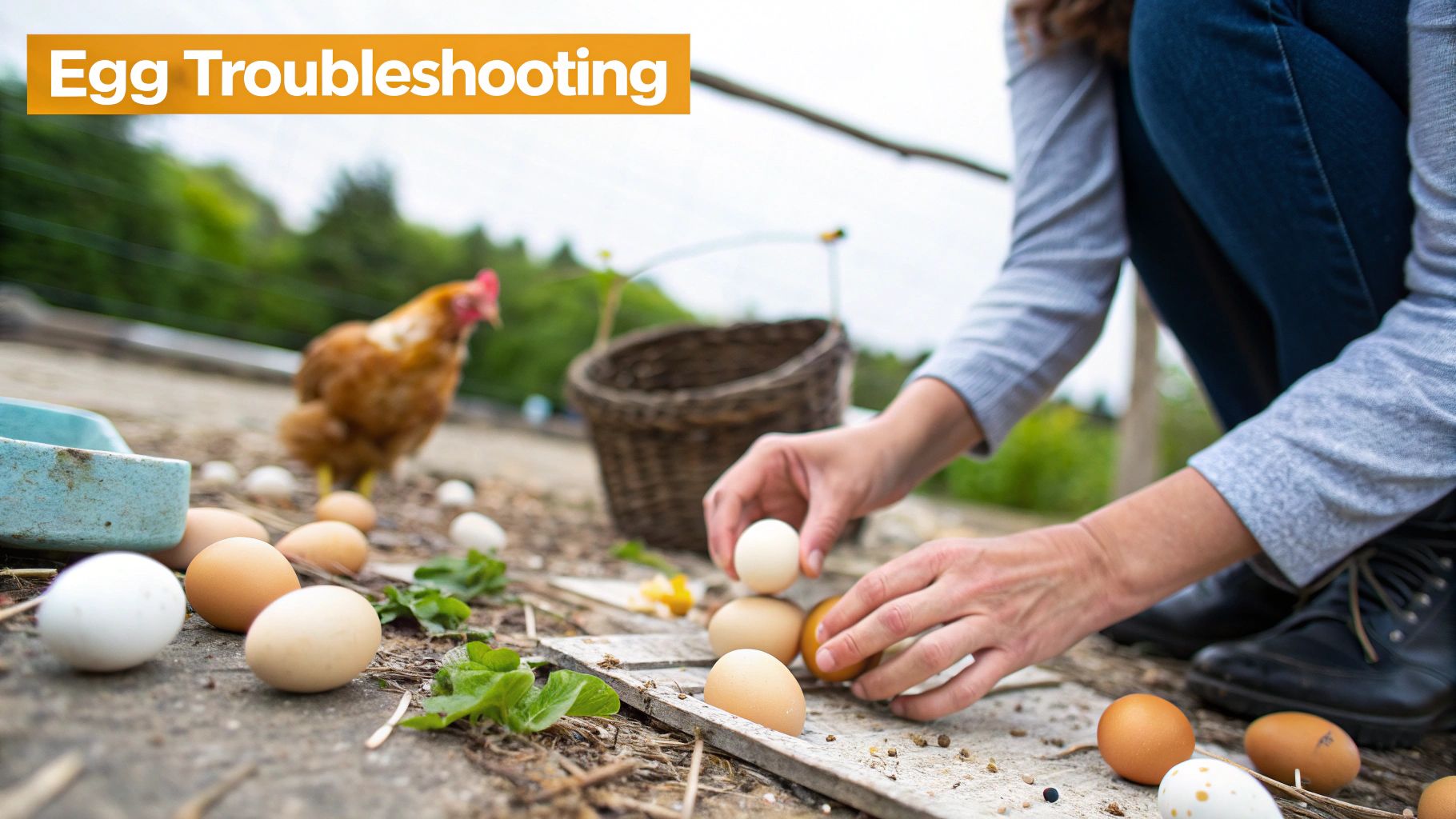
Even with the best-laid plans and a beautiful coop, you'll eventually run into a few quirks. Chickens have minds of their own, and sometimes their habits can disrupt an otherwise smooth chicken coop egg collection routine.
Don't panic. Every single person who has kept chickens has faced these issues, from eggs in weird places to the dreaded egg-eater. The good news is that most of these problems have simple fixes once you know what to look for.
The Mystery of Floor Eggs
Finding eggs laid everywhere but the nest box is one of the most common frustrations. You might find one in a dusty corner, another tucked under a feeder, or even one out in the middle of the run. This isn't just random; there's almost always a reason behind it.
Most of the time, the problem points back to the nest boxes. Are they too bright? Too dirty? Is there a bossy hen guarding them? Sometimes a young pullet just hasn't quite figured things out yet.
Here are a few tricks I've used that really work:
- Use Decoy Eggs: A golf ball or a ceramic egg placed in each nest box sends a clear signal to a young hen that this is the right place to lay.
- Block Off Unofficial Nests: If one of your girls has decided a specific corner is the perfect spot, make it unavailable. A simple box or board can break the habit.
- Keep Boxes Tidy and Inviting: Hens prefer a dark, private, and comfortable spot. Make sure the boxes are filled with deep, clean bedding.
My Personal Experience: I once had a hen who insisted on laying under the coop. After two days of blocking her chosen spot and placing a decoy egg in her favorite nest box, she got the hint. A little persistence goes a long way.
The Shock of Egg-Eating
It's a gut-wrenching sight: a hen pecking at or eating her own egg. This is a habit you have to stop fast, as it can spread through the flock and wreck your egg supply. It's usually triggered by a nutritional gap, boredom, or the accidental discovery that a broken egg is a tasty snack.
The number one culprit is often a calcium deficiency. Hens need a massive amount of calcium for strong shells. If their diet falls short, they'll look for it anywhere they can find it—including their own eggs. It's worth learning about the best calcium supplement for chickens to keep their diet balanced.
Beyond nutrition, your best defense is a quick collection. The less time eggs spend in the coop, the less chance they have of getting broken and tempting your flock.
Dealing with a Broody Hen
A broody hen is one who has decided it's time to become a mom. She’ll sit on the nest—with or without eggs—day and night, fluffing up her feathers and letting out a low growl at anyone who gets close. Her maternal drive is impressive, but she can hog a nest box and completely halt your chicken coop egg collection.
You’ll need to gently but firmly remove her from the nest several times a day. For really stubborn cases, many keepers use a "broody breaker," which is just a wire-bottomed cage. The airflow underneath helps cool her down and resets her hormones.
Make sure she always has access to food and water, but don't let her settle into another nesting spot. This process usually breaks the broodiness in a few days without causing any harm.
Here's a quick guide to help you pinpoint and fix these common issues as they pop up.
Common Egg Collection Issues and Solutions
| Problem | Potential Cause | Actionable Solution |
|---|---|---|
| Floor Eggs | Nest boxes are dirty, too bright, occupied, or the hen is a new layer. | Add decoy eggs (golf balls), clean and add fresh bedding, and block off unauthorized nesting spots. |
| Egg-Eating | Calcium deficiency, boredom, or an accidentally broken egg created a bad habit. | Collect eggs more frequently and provide a quality calcium supplement like crushed oyster shells. |
| Broody Hen | Natural maternal hormones are kicking in, causing her to "sit" on eggs to hatch them. | Gently remove her from the nest box multiple times a day. For stubborn cases, use a "broody breaker" cage for a few days. |
| Thin Shells | Insufficient calcium in the diet or heat stress. | Ensure a constant supply of oyster shell or another calcium source. Provide shade and cool water during hot weather. |
Getting a handle on these behaviors is part of the learning curve of keeping chickens. A little observation and quick action can keep your collection routine running smoothly.
Your Coop in the Global Egg Landscape
It’s easy to see your backyard flock as its own little world. The daily routine of a chicken coop egg collection feels personal, a quiet moment between you and your birds. But every egg you hold connects you to a massive global food system, making what you do more significant than you might think.
When you head out to the coop, you’re part of a tradition that’s a world away from large-scale agriculture. The global demand for eggs is staggering and it’s not slowing down. Over the last three decades, egg production has jumped by an incredible 115%, and it's projected to reach 99 million tonnes by 2025.
The thing is, the way most of those eggs get to the store is vastly different from your setup. A whopping 84% of the world's laying hens are housed in cage systems. Only about 12% enjoy cage-free environments like the one you've built, a number that really puts your efforts into perspective. If you're curious about these trends, you can find more data over at PoultryMed.com.
Industrial Scale Versus The Backyard Method
On a commercial egg farm, everything is about efficiency. Egg collection is a marvel of automation, with conveyor belts whisking eggs away from tiered enclosures to a central processing area. It’s a hands-off system built to handle thousands of eggs an hour.
That mechanical precision is a far cry from what you do. Your daily collection is hands-on. You’re checking on your hens, making sure they’re healthy, and keeping their nesting boxes clean and comfortable. It's a cycle of care that industrial operations just can't match.
Your small flock is a powerful counter-narrative to industrial farming. It’s a deliberate choice for better animal welfare, food transparency, and a real connection to where your food comes from.
Your Part in a Growing Movement
While your handful of hens won't show up on global production charts, they represent a meaningful and growing shift in how we think about food. Keeping chickens in your backyard is a real step toward food sovereignty and sustainability. It gives you a firsthand appreciation for the time, resources, and care that go into producing a single, perfect egg.
Every time you choose to raise your own flock, you're making a statement. You are:
- Championing Humane Practices: You’re providing a quality of life—with room to roam, fresh air, and the ability to just be chickens—that far exceeds industry norms.
- Slashing Food Miles: Your eggs travel a few feet from coop to kitchen, not hundreds of miles. That's a tiny carbon footprint.
- Guaranteeing Food Transparency: You have total control. You know exactly what your birds eat and how they live, giving you complete confidence in the food on your plate.
So, the next time you’re out on your chicken coop egg collection run, remember the bigger picture. You’re not just gathering breakfast; you’re nurturing a healthier, more conscious way of living.
Answering Your Top Egg Collection Questions
Even with the smoothest routine, questions about egg collection always seem to pop up. Let's dig into a few of the most common ones I hear from both new and seasoned chicken keepers, so you have the answers right when you need them.
Finding a weird, soft-shelled, or misshapen egg can be a little worrying, but it’s rarely a sign of a big problem. More often than not, it's just a little hiccup in a young pullet's reproductive system as she gets the hang of things. It can also be a sign your flock needs a bit more calcium. The easiest fix? Make sure a container of free-choice crushed oyster shell is always available. They'll take what they need to form strong, healthy shells.
How Long Can Eggs Really Stay in the Coop?
Life happens, and sometimes you just can't get out to the coop for the daily collection. So, how long is too long? Ideally, you want to gather eggs at least once a day. This keeps them clean, minimizes the risk of cracks, and prevents hens from developing bad habits like egg-eating.
But if you miss a day or two, don't panic. The eggs are almost certainly fine. Every egg is laid with a natural protective coating called a "bloom." As long as it's unwashed, an egg in a clean nest box can sit for up to a week in moderate temperatures (think 45°F to 65°F) and still be perfectly good. The bigger risk isn't spoilage—it's another hen accidentally cracking it or getting a taste and deciding she likes it.
A Quick Tip from Experience: The weather is your biggest guide. On a hot summer day, get those eggs inside quickly to preserve their quality. In the dead of winter, you need to collect them before they freeze and crack.
What’s the Deal with Fertilized Eggs?
If you have a rooster, you're going to have fertilized eggs. It's a common myth that they are somehow different or unsafe to eat, but that's simply not true. Nutritionally, a fertilized egg is identical to an unfertilized one, and it's completely safe to eat.
You can tell an egg is fertilized by candling it or by looking for a small, white "bullseye" on the yolk called a blastoderm. It won't start developing into an embryo unless it's kept consistently warm, which only happens if a broody hen sits on it for several days.
- If you plan to eat them: Just collect them daily and pop them in the fridge like any other egg. The cold temperature halts any potential development right in its tracks.
- If you want to hatch them: You'll need to either let a dedicated broody hen do her thing or gather the eggs to place in an incubator.
The stability of the U.S. commercial laying flock, which was around 359 million hens as of July 2025 after some major disruptions, really highlights the importance of small-scale backyard systems. Every backyard flock contributes to local food security. If you're curious, you can read more about the global egg market and recent trends on foodcom.pl.
Want to keep your flock healthy and their shells strong? Give them a treat they'll go crazy for. Pure Grubs offers premium, USA-grown Black Soldier Fly Larvae that are packed with the calcium your hens need for perfect eggs. Find out more and treat your flock at https://puregrubs.com.
